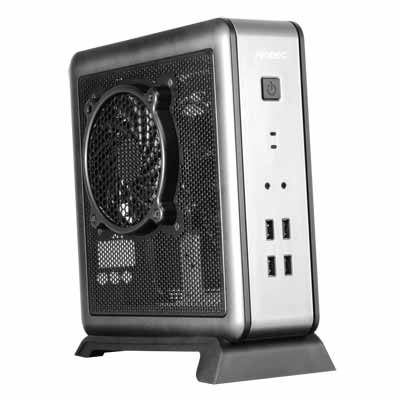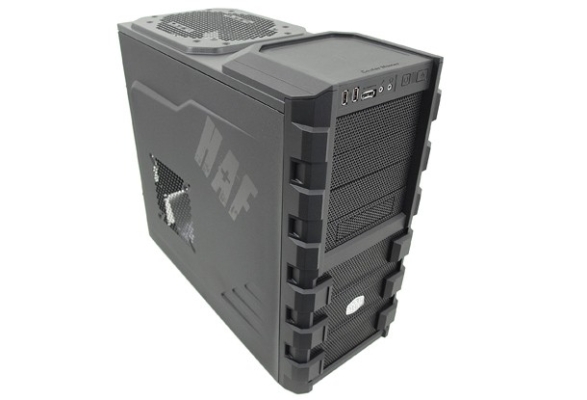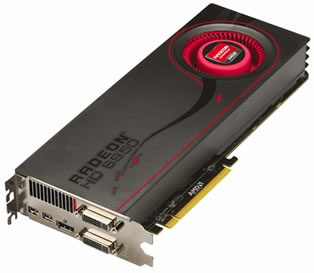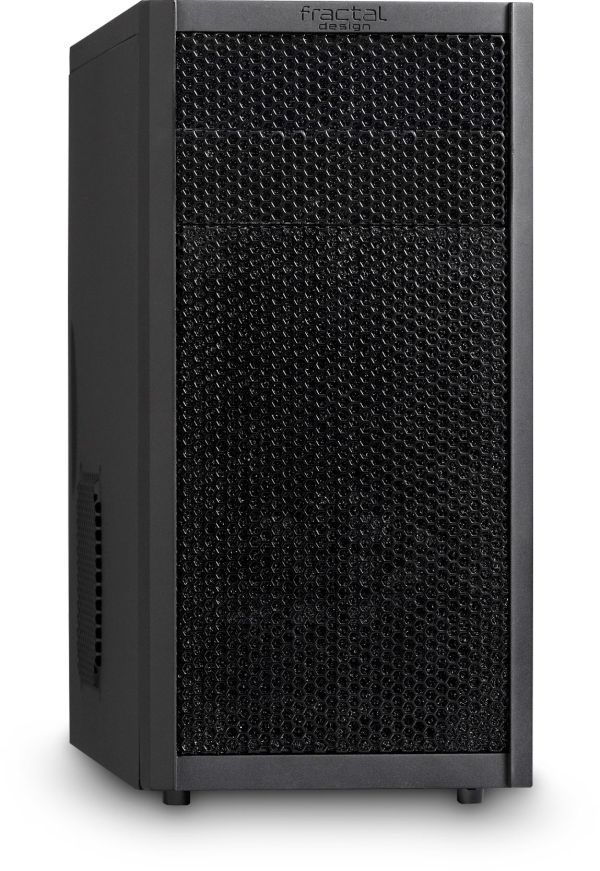Back To School Technology Buyer's Guide
by Zach Throckmorton on August 4, 2011 8:55 PM ESTBuild your own PC
You can usually build a desktop computer for less money than it costs to buy a comparably-specced system from a retailer. The discrepancy generally becomes greater as overall cost and capability go up. Additionally, many college students have access to very low cost Windows 7 licenses. For example, Windows 7 Ultimate costs students here at UW-Madison $64, while at Indiana University it's $20 and at the University of Michigan, $19 (Wolverines can also buy Vista for $9.50—curb your enthusiasm). Be sure to check with your specific college to see if you can get Windows (and other useful software) at a discount before paying retail prices for your OS. Because the cost of the OS varies dramatically from college to college, it is omitted from the following builds.
With that important consideration, let's get to the builds! We present here three configurations: a very tiny but capable mini-ITX system, a relatively small, inexpensive micro-ATX rig, and a more powerful mid-tower. We also suggest upgrades for each computer tailored to different uses.
Intel Mini-ITX System
| Intel Core i3 Sandy Bridge mini-ITX PC | |||||
| Component | Product Name | Cost | |||
| Case + PSU | Antec ISK 100 80W PSU | $85 | |||
| CPU | Intel Core i3-2100T | $135 | |||
| Motherboard | ASUS P8H61-I (Rev. 3.0) | $85 | |||
| Memory | Patriot 4GB (2x2GB) DDR3 SDRAM | $33 | |||
| Hard drive | Samsung Spinpoint MP4 HM320HJ 320GB | $48 | |||
| Total: | $386 | ||||

This mini-ITX system built in an Antec ISK 100 is more than powerful enough to handle web browsing, HD video playback, photo and video editing, many kinds of scientific analysis, and of course, office productivity. It's also sufficiently powerful that you should expect to be able to use it to perform these tasks for your entire four year undergraduate career. Best of all, its tiny case measures less than 9" tall by 9" deep by 4" wide. That's about the size of a hardcover novel (and smaller than an intro biology text!)—saving valuable real estate in a cramped dorm room, for example. Once assembled, it will weigh less than four pounds. It's important to note that the ultra low-profile heatsink that comes with the Core i3-2100T fits inside the ISK 100, but the stock heatsink that comes with the Core i3-2100 does not. Gelid makes a low-profile heatsink that would let you use a Core i3-2100 in the ISK 100 but it is difficult to find. Perhaps its only drawbacks given its size are that it lacks an optical drive and it is not a gaming computer, nor can it be upgraded to become a gaming computer. That said, there is room for two 2.5" hard drives, so you could certainly upgrade it for faster responsivity by adding an SSD or for more storage by adding a more spacious, slower 2.5" mechanical drive.
AMD Micro-ATX System
| AMD Athlon II X3 Micro-ATX PC | ||
| Component | Product Name | Cost |
| Case | Fractal Design Core 1000 | $50 |
| PSU | XIGMATEK ACXTNRP-PC402 400W | $35 |
| CPU | AMD Athlon II X3 445 | $75 |
| Motherboard | Biostar A880G+ | $55 |
| Memory | Patriot 4GB (2x2GB) DDR3 SDRAM | $33 |
| Hard drive | Western Digital WD5000AAKX 500GB | $40 |
| Optical drive | LITE-ON iHAS124-04 | $20 |
| Total: | $298 | |
While the AMD Athlon II X3 445 is slightly less powerful than the Intel Core i3-2100T in the mini-ITX system, it is nevertheless a potent processor up to most tasks, and certainly more than sufficient to provide four years of basic computing. This AMD CPU offers tremendous value—a lot of bang for the buck. Importantly, should you deem more power necessary in a few years, the six core Thuban CPUs will be simple, drop-in upgrades and by then, likely will cost less than $100. That said, the tri-core chip will remain a capable office system processor for four years. For an idea of how it performs, check AnandTech's Bench.
The Fractal Design Core 1000 is one of my favorite newer cases to hit the market. Its low price tag, quality construction, smaller size, and aesthetics are major selling points. At less than 17" deep by 7" wide by 14" tall, it's more compact than many micro-ATX cases, yet large enough to hold many hard drives, a bigger aftermarket CPU heatsink, and/or a larger GPU if you want to upgrade it. I find its thermals are slightly improved by moving the front intake fan to the rear of the case to act as an exhaust.
Biostar's A880G+ is a great value; it's a well-featured budget board that even has an HDMI port, and its integrated Radeon HD 4250 graphics are more than adequate for running Windows' Aero feature and Flash games. Perhaps its only drawback at this price point is its lack of USB 3.0 ports, which will become increasingly useful, though again at this low price, they aren't expected (and a USB 3.0 expansion bracket could be added later if the need arises). Finally, the Xigmatek PC402 400W PSU is relatively well-built for its price tag, and has a quiet 140mm fan.
This system could easily be turned into a respectable gaming rig by adding a discrete video card. Given the thermal limitations of the case at stock, I suggest adding a 120mm fan for better airflow. And given the limitations of the 400W PSU, I wouldn't add a GPU that's more power-hungry than a Radeon HD 6870, and even that would require a molex-PCIe adapter. The Radeon HD 6770 (the rebadged Radeon HD 5770) remains a very strong value for $100 or less after rebate, providing gamers acceptable frame rates or better at resolutions lower than 1080p with medium settings in all but the most demanding games.
Intel Mid-Tower System
| Intel Core i5 Sandy Bridge ATX PC | |||
| Component | Product Name | Cost | Rebate |
| Case | Cooler Master HAF 912 | $75 | -$10 |
| PSU | Antec Earthwatts 430W | $44 | |
| CPU | Intel Core i5-2500K | $220 | |
| CPU heatsink | Cooler Master Hyper 212+ | $30 | |
| Motherboard | Biostar TZ68A+ | $100 | |
| Memory | Patriot 8GB Gamer 2 Series (2x4GB) DDR3 SDRAM | $55 | -$20 |
| Primary storage | OCZ Vertex 2 solid state drive | $100 | |
| Secondary storage | Western Digital 1TB 5400RPM WD10EARS hard drive | $55 | |
| Video card | XFX HD-679X-ZDFC Radeon HD 6790 | $135 | -$15 |
| Optical drive | Samsung SH-222AB | $19 | |
| Total: | $833 | $788 | |

If you have more space than a typical dorm room (or think having a powerful computer is worth being even more cramped than usual in a dorm room), this midtower has all the bases covered. The Cooler Master HAF 912 features excellent thermals (HAF stands for high air flow), integrated mounts for 2.5" SSDs, solid cable management, and it's capacious enough for larger video cards and aftermarket CPU heatsinks. At 20" deep by just over 9" wide by 19" tall and weighing in at 18 pounds, it's probably not going to disappear if you inadvertently leave your room unlocked.
The Intel Core i5-2500K is an extremely potent CPU that will remain a very solid processor for four more years (think of how 2007's Q6600 is still a capable chip). Its performance metrics are available in Bench. The Cooler Master Hyper 212+ is a great value, and should allow you to overclock the CPU to 4GHz with minimal effort, though better chips can hit 4.5GHz and some even approach 5GHz. I've had excellent results from the Biostar motherboard in terms of overclocking, and its low price for a Z68-chipset board with all the bells and whistles makes it a compelling option. Of course, a system like this should have an SSD for overall responsiveness, and the OCZ Vertex 2 is a venerable stalwart at an increasingly low price. The 1TB low RPM hard drive offers plenty of storage, though you could certainly swap it out for a larger, faster (i.e. 7200RPM) hard drive if you'll be installing a lot of games that won't fit on the SSD and will benefit from not being put on a 'green' drive.

Finally, we've opted to recommend a Radeon HD 6790 because of its value, though a GeForce GTX 460 1GB might be worth spending a few dollars more for a bit better performance. If you want to spring for GPUs that will play the latest titles for a year or two longer than these, consider the AMD Radeon HD 6950 and NVIDIA GeForce GTX 560 Ti. These cards trade blows both in terms of performance and are priced at $200 or slightly higher.
While these do it yourself builds cover a range of typical college uses and needs, we recognize that many readers prefer retail, pre-built systems. Therefore a few models are discussed on the next page.











94 Comments
View All Comments
blueeyesm - Friday, August 5, 2011 - link
Sure, get a MacBook and discover that you overpaid for a computer that can't run a required application for your program.How do I know this? I work for a university where I have seen this time and again. As StormyParis said, you should try being what you do, not what you own.
Sure, install Parallels and Windows. But you need to pay for your copy of Windows. More money spent where it could have gone to books or food.
Portability became "key" due to a trend where it was "cool" to have something lightweight and you could take it with you. A convenience that was turned into necessity. Before that, students along just fine with desktops.
Dorms provide desk space, thus yes it DOES work. It is not 0 chance, nor retarded.
If you are worried about theft, get a Kensington cable lock and lock it all down.
antef - Saturday, August 6, 2011 - link
I only graduated undergrad in 2009, so definitely during a period where laptops were plenty affordable, yet I got through college just fine with only my gaming rig and no laptop. I even had a 5.1 sound system and lived in a super cramped, wedge-shaped room one year with a roommate. Yes it was crowded but completely fine. I never had a need for a laptop - they only distract you in class and a notebook and pen work fine for notes. I didn't go the library much as I found it no better a place to study than my own dorm or apartment, but when I did there were public computers available. If you need/want a desktop as I did, you can definitely save money by not having a laptop also if you don't need it. However, I realize most students love going to the library or coffee shops or whatever to do work, in which case you'll want one. Also, if you have no need for a desktop, the laptop is a better option because it's less of a hassle when moving.shellcrash - Saturday, August 6, 2011 - link
There is also a common denominator issue going on: not everyone is expected to have a laptop. If one is required, the prof borrows one from the IT department.I graduated in 2006 & laptops were affordable, but they have durability issues that show up when in frequent transportation or use. In random work meetings having a desk & environment designed for work is much better than trying to do serious work in a laid back coffee shop environment; I stopped using my laptop when I started using my Palm (or was it lol TI-89?) & flash drive effectively. It also didn't help that the fans on the laptop died and some keys stopped working on the keyboard.
The reviews didn't cover phones, although it is the 2nd most crucial instrument in college. Needs to be able to be backed up to computer and do fast assignment scheduling.
anishannayya - Monday, August 8, 2011 - link
75% (really closer to 50%) percent of my classmates didn't have to spend a dime for their computers.50% of my classmates aren't CS/Engineering majors.
The 20% of CS/Engineering majors that have a Mac inevitably end up having to install and use Windows.
The only Mac worth the money is the Air. For everything else, your better off with a Thinkpad.
Lastly, Macs look great, but durability is very important when you take your device everywhere.
And RE desktops: Many gamers bring their desktop.
Neo Elemental - Monday, August 15, 2011 - link
I had a desktop all the years I was in college. To some, having additional horsepower is a non-negotiable (think games). I did end up caving and getting a netbook in my senior year.I don't see how the desktop+netbook combo is any less feasible or attractive for someone at an equivalent price (except that not everyone can build their own desktop).
This isn't the site for those who are just going to get a Macbook because they can afford it. A majority of the things mentioned/reviewed on this site are focused towards desktops and non-Apple systems.
mfenn - Thursday, August 4, 2011 - link
You make a big deal about constrained space when you talk about the PC itself, but you seem to completely forget about it when you recommend dual monitors. A tower can easily be tucked under a bed or desk, a second 22" monitor cannot.Kaboose - Friday, August 5, 2011 - link
Wall mount :D(mnewsham)
Friendly0Fire - Thursday, August 4, 2011 - link
"And given the limitations of the 400W PSU, I wouldn't add a GPU that's more power-hungry than a Radeon HD 6970."Surely you meant a 6790? The 6970 isn't exactly sipping power.
Gigantopithecus - Thursday, August 4, 2011 - link
Nope, the 6970 is not exactly a power sipper, but at peak during gaming it draws less than 200W. The rest of the system at stock without more components added isn't going to draw more than another 120W or so, and that leaves 20%+ headroom on the PSU. The link to Bench I gave with that line shows the 6970 using 340W from the wall, and the Bench test platform is a more power-hungry system than the one in this guide. A friend of mine is rockin' a GTX 560 Ti (a slightly less power-hungry card than the 6970) with a mildly OC'd AMD PII X4 (a 125W CPU vs the 95W CPU in the guide), two fans, one HDD system on this same PSU with no issues. It's a good PSU.JarredWalton - Friday, August 5, 2011 - link
Well, I've run a single 5870 off of a 500W PSU, and power draw at the outlet never got about 380W. Accounting for efficiency, a 400W PSU should still handle a 6970, but you wouldn't want to load it up with other extras or extreme overclocking.